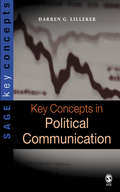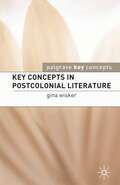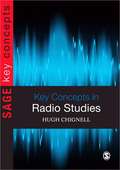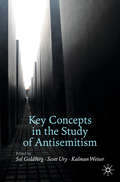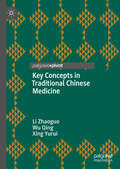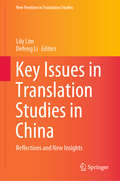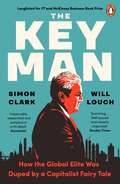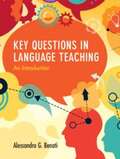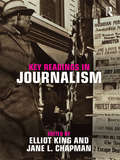- Table View
- List View
Key Concepts in Literary Theory
by Julian Wolfreys Ruth Robbins Kenneth WomackThis book provides students with lucid and authoritative definitions of some of the most significant terms and concepts employed in the study of literary theory. It offers 250 terms from many areas of literary theory, including cultural studies, psychoanalysis, poststructuralism, Marxist and feminist studies, postcolonialism, and other areas of identity politics. In addition, it provides definitions of principal areas of literary study, and a chronological chart of major critics and philosophers. Key Concepts in Literary Theory is an indispensable reference work for anyone interested in the complexities of the theories currently discussed in literary and cultural studies.
Key Concepts in Literary Theory (Key Concepts In Literature Ser.)
by Julian Wolfreys Ruth Robbins Kenneth WomackThis book provides students with lucid and authoritative definitions of some of the most significant terms and concepts employed in the study of literary theory. It offers 250 terms from many areas of literary theory, including cultural studies, psychoanalysis, poststructuralism, Marxist and feminist studies, postcolonialism, and other areas of identity politics. In addition, it provides definitions of principal areas of literary study, and a chronological chart of major critics and philosophers. Key Concepts in Literary Theory is an indispensable reference work for anyone interested in the complexities of the theories currently discussed in literary and cultural studies.
Key Concepts in Political Communication
by Darren LillekerThis is a systematic and accessible introduction to the critical concepts, structures and professional practices of political communication. Lilleker presents over 50 core concepts in political communication which cement together various strands of theory. From aestheticisation to virtual politics, he explains, illustrates and provides selected further reading. He considers both practical and theoretical issues central to political communication and offers a critical assessment of recent developments in political communication.
Key Concepts in Political Communication (PDF)
by Darren LillekerThis is a systematic and accessible introduction to the critical concepts, structures and professional practices of political communication. Lilleker presents over 50 core concepts in political communication which cement together various strands of theory. From aestheticisation to virtual politics, he explains, illustrates and provides selected further reading. He considers both practical and theoretical issues central to political communication and offers a critical assessment of recent developments in political communication.
Key Concepts in Postcolonial Literature (Key Concepts: Literature)
by Gina WiskerKey Concepts in Postcolonial Literature provides an overview of the main themes, issues and critical perspectives that have had the greatest effect on postcolonial literatures. Discussing historical, cultural and contextual background, it contains selected work of some of the major writers from this period.
Key Concepts in Postcolonial Literature (Key Concepts: Literature)
by Gina WiskerKey Concepts in Postcolonial Literature provides an overview of the main themes, issues and critical perspectives that have had the greatest effect on postcolonial literatures. Discussing historical, cultural and contextual background, it contains selected work of some of the major writers from this period.
Key Concepts In Radio Studies (PDF)
by Hugh Chignell'This innovative and clearly written handbook does exactly what it claims on the cover, providing students with accessible and authoritative knowledge of the essential topics in Radio Studies. Chignell writes about radio with an engaging mixture of scholarly detachment and private passion' - The Radio Journal.
Key Concepts in Second Language Acquisition (Key Concepts)
by Shawn Loewen Hayo ReindersWhat does it mean to acquire a language? What is considered a 'second' language in multilingual settings? This practical and comprehensive guide provides an opportunity to consider these issues, providing easy access to concise definitions of key terms and concepts in the study of Second Language Acquisition.
Key Concepts in the Study of Antisemitism (Palgrave Critical Studies of Antisemitism and Racism)
by Scott Ury Kalman Weiser Sol GoldbergThis volume is designed to assist university faculty and students studying and teaching about antisemitism, racism, and other forms of prejudice. In contrast with similar volumes, it is organized around specific concepts instead of chronology or geography. It promotes conversation about antisemitism across disciplinary, geographic, and thematic lines rather than privileging a single methodological paradigm, a specific academic field, or an overarching narrative. Its twenty-one chapters by leading scholars in diverse fields address the relationship to antisemitism of concepts ranging from Anti-Judaism to Zionism. Each chapter not only traces the history and major scholarly debates around a key concept; it also presents an original argument, points to avenues for further research, and exemplifies a method of investigation.
Key Concepts in Traditional Chinese Medicine
by Li Zhaoguo Wu Qing Xing YuruiThis book offers a comprehensive overview of Chinese medicine terminology translation, defining the most central concepts in Chinese traditional medicine, providing simplified Chinese characters, Mandarin Pronunciation in pinyin, citations for 111 of the most key concepts in traditional Chinese medicine and culture. Covering definitions of terms relating to essence, qi, yin-yang theory, five elements and visceral manifestation in traditional medicine, it offers a selection of English versions of each term in addition to a standard English version, drawing on the translation history of traditional Chinese medicine. It provides a useful resource to understand the fundamental terms of traditional Chinese medicine and culture in Chinese and English, and their relevance to cross-cultural discourse.
Key Essays: Mapping the Contemporary in Literature and Culture
by Johnny RodgerAny level of study within literature and culture requires an engagement with a wider scope of themes, issues and discourses, and these debates are often centred around key ‘essays’. This book examines a wide range of these essays on topics such as posthumanism, racism, feminism, necropolitics, the Anthropocene, gender, Global North/South, neo- and de-colonialism, universals, borders and limits, interspecies relations, blackness, cosmopolitics, epistemology, addiction. The essays selected represent scholars from a range of disciplines, ethnicities, nationalities and genders, and offer readings relevant across the arts and humanities. Each chapter explains why the essay is of vital importance in our contemporary era, introduces and explains the key themes and theories with which it engages, demystifies any complex content and positions it within wider current debates. Covering all of the essential debates that students and academics must engage with, alongside a close analysis and critique of contemporary seminal essays in the debate, this book will be an essential read for students of literature and culture across the arts and humanities.
Key Essays: Mapping the Contemporary in Literature and Culture
by Johnny RodgerAny level of study within literature and culture requires an engagement with a wider scope of themes, issues and discourses, and these debates are often centred around key ‘essays’. This book examines a wide range of these essays on topics such as posthumanism, racism, feminism, necropolitics, the Anthropocene, gender, Global North/South, neo- and de-colonialism, universals, borders and limits, interspecies relations, blackness, cosmopolitics, epistemology, addiction. The essays selected represent scholars from a range of disciplines, ethnicities, nationalities and genders, and offer readings relevant across the arts and humanities. Each chapter explains why the essay is of vital importance in our contemporary era, introduces and explains the key themes and theories with which it engages, demystifies any complex content and positions it within wider current debates. Covering all of the essential debates that students and academics must engage with, alongside a close analysis and critique of contemporary seminal essays in the debate, this book will be an essential read for students of literature and culture across the arts and humanities.
Key Issues in Chinese as a Second Language Research
by Istvan Kecskes Chaofen SunKey Issues in Chinese as a Second Language Research presents and discusses research projects that serve as theoretical grounding for improving the teaching and learning of Chinese as a second language (CSL) in order to help researchers and practitioners better understand the acquisition, development, and use of CSL. With the exception of the first chapter, which is state-of-the-art, each chapter makes an attempt to bring together theory and practice by focusing on theory building and theory application in practice. The book is organized around areas where most future research is needed in CSL: phonology, semantics, grammar, and pragmatics. Consisting of contributions from an international group of scholars working on cutting-edge research, this is the ideal text for researchers, graduate students, and practitioners in the area of Chinese as a second or foreign language.
Key Issues in Chinese as a Second Language Research
by Istvan Kecskes Chaofen SunKey Issues in Chinese as a Second Language Research presents and discusses research projects that serve as theoretical grounding for improving the teaching and learning of Chinese as a second language (CSL) in order to help researchers and practitioners better understand the acquisition, development, and use of CSL. With the exception of the first chapter, which is state-of-the-art, each chapter makes an attempt to bring together theory and practice by focusing on theory building and theory application in practice. The book is organized around areas where most future research is needed in CSL: phonology, semantics, grammar, and pragmatics. Consisting of contributions from an international group of scholars working on cutting-edge research, this is the ideal text for researchers, graduate students, and practitioners in the area of Chinese as a second or foreign language.
Key Issues in English for Specific Purposes in Higher Education (English Language Education #11)
by Yasemin Kırkgöz Kenan DikilitaşThis volume offers research-based studies on English for Specific Purposes in higher education from across the world. By drawing on international studies, the book brings together diverse ESP practices and aspects of relevant issues in the development of ESP programs, teachers and learners in a coherent fashion. There is a growing need for undergraduate students to develop their proficiency of ESP skills and knowledge in the increasingly globalized world. Knowledge of ESP is an important factor in subject matter learning by students, and also closely related to the performance of university graduates in the relevant sectors. Careful planning and efficient implementation are essential to ensure the quality of the language learning process. For a variety of reasons, it proves difficult to maintain ESP instruction in higher education. These reasons include the incompetence of teachers, lack of materials for that specific context, as well as lack of opportunities for ESP teachers to develop their skills. The chapters in this book, taken from a wide variety of countries, shed light on the diversity of current practices and issues surrounding ESP.
Key Issues in Historical Theory
by Herman PaulKey Issues in Historical Theory is a fresh, clear and well-grounded introduction to this vibrant field of inquiry, incorporating many examples from novels, paintings, music, and political debates. The book expertly engages the reader in discussions of what history is, how people relate to the past and how they are formed by the past. Over 11 thematically-based chapters, Herman Paul discusses subjects such as: history, memory and trauma historical experience and narrative moral and political dimensions of history historical reasoning and explanation truth, plausibility and objectivity. Key Issues in Historical Theory convincingly shows that historical theory is not limited to reflection on professional historical studies, but offers valuable tools for understanding autobiographical writing, cultural heritage and political controversies about the past. With textboxes providing additional focus on a range of key topics, this is an attractive, accessible and up-to-date guide to the field of historical theory.
Key Issues in Historical Theory
by Herman PaulKey Issues in Historical Theory is a fresh, clear and well-grounded introduction to this vibrant field of inquiry, incorporating many examples from novels, paintings, music, and political debates. The book expertly engages the reader in discussions of what history is, how people relate to the past and how they are formed by the past. Over 11 thematically-based chapters, Herman Paul discusses subjects such as: history, memory and trauma historical experience and narrative moral and political dimensions of history historical reasoning and explanation truth, plausibility and objectivity. Key Issues in Historical Theory convincingly shows that historical theory is not limited to reflection on professional historical studies, but offers valuable tools for understanding autobiographical writing, cultural heritage and political controversies about the past. With textboxes providing additional focus on a range of key topics, this is an attractive, accessible and up-to-date guide to the field of historical theory.
Key Issues in the Teaching of Spanish Pronunciation: From Description to Pedagogy (Routledge Advances in Spanish Language Teaching)
by Rajiv RaoKey Issues in the Teaching of Spanish Pronunciation: From Description to Pedagogy is a resource that encourages Spanish teachers and curriculum designers to increase their incorporation of pronunciation into the classroom. Combining theory and practical guidance, it will help language practitioners integrate the teaching of Spanish pronunciation with confidence and effectiveness. The international group of scholars across its 15 chapters is made up of individuals with well-established research records and training in best pedagogical practices. Key features: A range of topics including vowels, various classes of consonants, prosody, the use of technology, the role of orthography, the importance of both perception and production, individual learner differences, and teacher training; Overviews of descriptive, empirical, and acquisition-based research associated with each aspect of the Spanish sound system; Guidance on the difficulties that teachers face when incorporating the teaching of pronunciation into the classroom; Clear explanations of concepts, accompanied by an abundance of concrete examples and references; Multiple sample activities and lesson plans tailored to different levels and backgrounds of students; A bilingual glossary of terms to help the content reach the widest audience possible. Written in a clear and accessible manner, Key Issues in the Teaching of Spanish Pronunciation is an essential resource for teachers of Spanish at all levels. It is also an excellent reference book for researchers and both undergraduate and graduate university students interested in Spanish phonetics and language acquisition.
Key Issues in Translation Studies in China: Reflections and New Insights (New Frontiers in Translation Studies)
by Lily Lim Defeng LiThis book revisits a number of key issues in Chinese Translation Studies. Reflecting on e.g. what Translation Studies researchers have achieved in the past, and the extent to which the central issues have been addressed and what still needs to be done, a group of respected scholars share their expertise in order to identify some tangible directions and potential areas for future research. In addition, the book discusses a number of key themes, e.g. Translation Studies as a discipline and its essential characteristics, the cultural dimension in translator training, paradigms of curriculum design, the reform of assessment for professional qualification, acts and translation shifts, the principle of faithfulness in translation, and interpreter’s cognitive processing routes. The book offers a useful reference guide for a broad readership including graduate students, and shares insiders’ accounts of various current topics and issues in Chinese Translation Studies. Given its scope, it is also a valuable resource for researchers interested in translation studies in the Chinese context.
The Key Man: How the Global Elite Was Duped by a Capitalist Fairy Tale
by Simon Clark Will Louch'A scorching epilogue' The Sunday Times'A riveting account of the intertwining of brilliance and greed' The Business StandardIn this compelling story of greed, chicanery and tarnished idealism, two Wall Street Journal reporters investigate a man who Bill Gates and Western governments entrusted with hundreds of millions of dollars to make profits and end poverty but now stands accused of masterminding one of the biggest, most brazen frauds ever.Arif Naqvi was charismatic, inspiring and self-made. The founder of the Dubai-based private-equity firm Abraaj, he was the Key Man to the global elite searching for impact investments to make money and do good. He persuaded politicians he could help stabilize the Middle East after 9/11 by providing jobs and guided executives to opportunities in cities they struggled to find on the map. Bill Gates helped him start a billion-dollar fund to improve health care in poor countries, and the UN and Interpol appointed him to boards. Naqvi also won the support of President Obama's administration and the chief of a British government fund compared him to Tom Cruise in Mission: Impossible.The only problem? In 2019 Arif Naqvi was arrested on charges of fraud and racketeering at Heathrow airport. A British judge has approved his extradition to the US and he faces up to 291 years in jail if found guilty.With a cast featuring famous billionaires and statesmen moving across Asia, Africa, Europe and America, The Key Man is the story of how the global elite was duped by a capitalist fairy tale. Clark and Louch's thrilling investigation exposes one of the world's most audacious scams and shines a light on the hypocrisy, corruption and greed at the heart of the global financial system.'An unbelievable true tale of greed, corruption and manipulation among the world's financial elite' Harry Markopolos, the Bernie Madoff whistleblower
The Key of Green: Passion and Perception in Renaissance Culture
by Bruce R. SmithFrom Shakespeare’s “green-eyed monster” to the “green thought in a green shade” in Andrew Marvell’s “The Garden,” the color green was curiously prominent and resonant in English culture of the sixteenth and seventeenth centuries. Among other things, green was the most common color of household goods, the recommended wall color against which to view paintings, the hue that was supposed to appear in alchemical processes at the moment base metal turned to gold, and the color most frequently associated with human passions of all sorts. A unique cultural history, The Key of Green considers the significance of the color in the literature, visual arts, and popular culture of early modern England. Contending that color is a matter of both sensation and emotion, Bruce R. Smith examines Renaissance material culture—including tapestries, clothing, and stonework, among others—as well as music, theater, philosophy, and nature through the lens of sense perception and aesthetic pleasure. At the same time, Smith offers a highly sophisticated meditation on the nature of consciousness, perception, and emotion that will resonate with students and scholars of the early modern period and beyond. Like the key to a map, The Key of Green provides a guide for looking, listening, reading, and thinking that restores the aesthetic considerations to criticism that have been missing for too long.
The Key of Green: Passion and Perception in Renaissance Culture
by Bruce R. SmithFrom Shakespeare’s “green-eyed monster” to the “green thought in a green shade” in Andrew Marvell’s “The Garden,” the color green was curiously prominent and resonant in English culture of the sixteenth and seventeenth centuries. Among other things, green was the most common color of household goods, the recommended wall color against which to view paintings, the hue that was supposed to appear in alchemical processes at the moment base metal turned to gold, and the color most frequently associated with human passions of all sorts. A unique cultural history, The Key of Green considers the significance of the color in the literature, visual arts, and popular culture of early modern England. Contending that color is a matter of both sensation and emotion, Bruce R. Smith examines Renaissance material culture—including tapestries, clothing, and stonework, among others—as well as music, theater, philosophy, and nature through the lens of sense perception and aesthetic pleasure. At the same time, Smith offers a highly sophisticated meditation on the nature of consciousness, perception, and emotion that will resonate with students and scholars of the early modern period and beyond. Like the key to a map, The Key of Green provides a guide for looking, listening, reading, and thinking that restores the aesthetic considerations to criticism that have been missing for too long.
Key Questions In Language Teaching: An Introduction
by Alessandro G. Benatinnovative and evidence-based, this introduction to the main concepts and issues in language teaching uses a 'key questions' structure, enabling the reader to understand how these questions have been addressed by researchers previously, and how the findings inform language teaching practices. Grounded in research, theory and empirical evidence, the textbook provides students, practitioners and teachers with a complete introductory course in language teaching. Written in a clear and user-friendly style, and avoiding use of jargon, the book draws upon real-life teaching experiences and scenarios to provide practical advice. A glossary of key terms, questions for discussion and further reading suggestions are included. The book is perfectly suited to language teaching modules on English language, TESOL and applied linguistics courses.
Key Readings in Journalism
by Elliot King Jane ChapmanKey Readings in Journalism brings together over thirty essential writings that every student of journalism should know. Designed as a primary text for undergraduate students, each reading was carefully chosen in response to extensive surveys from educators reflecting on the needs of today’s journalism classroom. Readings range from critical and historical studies of journalism, such as Walter Lippmann’s Public Opinion and Michael Schudson’s Discovering the News, to examples of classic reporting, such as Carl Bernstein and Bob Woodward’s All the President’s Men. They are supplemented by additional readings to broaden the volume’s scope in every dimension, including gender, race, and nationality. The volume is arranged thematically to enable students to think deeply and broadly about journalism—its development, its practice, its key individuals and institutions, its social impact, and its future—and section introductions and headnotes precede each reading to provide context and key points for discussion.
Key Readings in Journalism
by Elliot King Jane ChapmanKey Readings in Journalism brings together over thirty essential writings that every student of journalism should know. Designed as a primary text for undergraduate students, each reading was carefully chosen in response to extensive surveys from educators reflecting on the needs of today’s journalism classroom. Readings range from critical and historical studies of journalism, such as Walter Lippmann’s Public Opinion and Michael Schudson’s Discovering the News, to examples of classic reporting, such as Carl Bernstein and Bob Woodward’s All the President’s Men. They are supplemented by additional readings to broaden the volume’s scope in every dimension, including gender, race, and nationality. The volume is arranged thematically to enable students to think deeply and broadly about journalism—its development, its practice, its key individuals and institutions, its social impact, and its future—and section introductions and headnotes precede each reading to provide context and key points for discussion.

